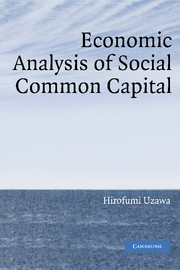Book contents
- Frontmatter
- Contents
- List of Figures
- Preface
- Introduction: Social Common Capital
- 1 Fisheries, Forestry, and Agriculture in the Theory of the Commons
- 2 The Prototype Model of Social Common Capital
- 3 Sustainability and Social Common Capital
- 4 A Commons Model of Social Common Capital
- 5 Energy and Recycling of Residual Wastes
- 6 Agriculture and Social Common Capital
- 7 Global Warming and Sustainable Development
- 8 Education as Social Common Capital
- 9 Medical Care as Social Common Capital
- Main Results Recapitulated
- References
- Index
6 - Agriculture and Social Common Capital
Published online by Cambridge University Press: 18 December 2009
- Frontmatter
- Contents
- List of Figures
- Preface
- Introduction: Social Common Capital
- 1 Fisheries, Forestry, and Agriculture in the Theory of the Commons
- 2 The Prototype Model of Social Common Capital
- 3 Sustainability and Social Common Capital
- 4 A Commons Model of Social Common Capital
- 5 Energy and Recycling of Residual Wastes
- 6 Agriculture and Social Common Capital
- 7 Global Warming and Sustainable Development
- 8 Education as Social Common Capital
- 9 Medical Care as Social Common Capital
- Main Results Recapitulated
- References
- Index
Summary
INTRODUCTION
Agriculture concerns not only economic and industrial aspects but also virtually every aspect of human life – cultural, social, and natural. It provides us with food and the raw materials such as wood, cotton, silk, and others that are indispensable in sustaining our existence. It also has sustained, with few exceptions, the natural environment such as forests, lakes, wetlands, soil, subterranean water, and the atmosphere.
Agriculture has made possible a harmonious and sustainable interaction between nature and humankind through the social institution of the rural community in many East Asian countries, particularly Japan. This does not, however, necessarily imply that the traditional, conventional social institutions prevailing in most of the agricultural communities are justifiable or desirable.
Land ownership is probably the single most serious and complex problem in Japan. Japan is noted for a high population density and a long history of agricultural development. Land had been cultivated literally to the top of the mountains, and forestry had been subject to a myriad of property rights arrangements. The modern Civil Law, enacted in 1898, adopted an extremely narrow definition of land ownership, voiding traditional forms of property ownership for villages as the commons to manage and control the natural resources to be directly or indirectly obtained from land, forests, and other natural environments. The conflict between the modern Civil Law and traditional institutions of the commons occupied the majority of the legal suits brought before the Grand Court before the Second World War.
- Type
- Chapter
- Information
- Economic Analysis of Social Common Capital , pp. 219 - 256Publisher: Cambridge University PressPrint publication year: 2005
- 1
- Cited by



